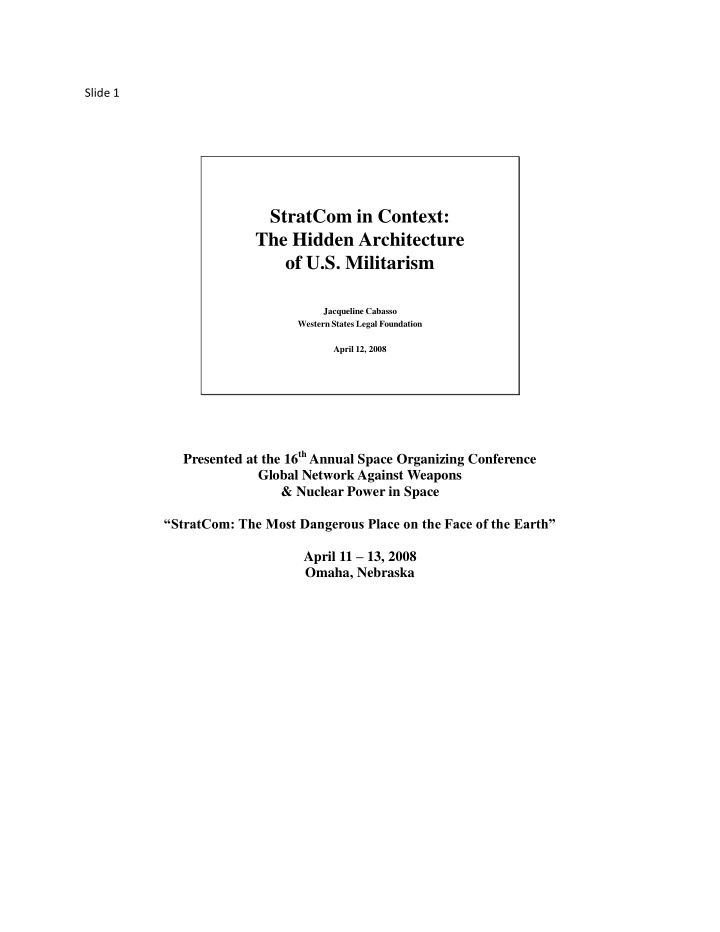



Slide 1 StratCom in Context: The Hidden Architecture of U.S. Militarism Jacqueline Cabasso Western States Legal Foundation April 12, 2008 Presented at the 16 th Annual Space Organizing Conference Global Network Against Weapons & Nuclear Power in Space “StratCom: The Most Dangerous Place on the Face of the Earth” April 11 – 13, 2008 Omaha, Nebraska
Slide 2 Our Mission: Provide the nation with global deterrence capabilities and synchronized DoD effects to combat adversary weapons of mass destruction worldwide. Enable decisive global kinetic and non-kinetic combat effects through the application and advocacy of integrated intelligence, surveillance and reconnaissance (ISR); space and global strike operations; information operations; integrated missile defense and robust command and control. United States Strategic Command: http://www.stratcom.mil/
Slide 3 US Military Troops and Bases Around the World, 2002 Sources: Dept. of Defense, “Base Structure Report, FY 02” and “Active Duty Military Personnel Strengths by Regional area and by Country, Dec. 31 , 2001”: Zoltan Grossman, “New U.S. Military Bases,” Feb. 2, 2002; Monthly Review, 2002 http://dusteye.files.wordpress.com/2007/03/usmilitarymap.jpg
Slide 4 Unified Combatant Commands (6 geographic and 4 functional) • United States Northern Command (NORTHCOM) • United States Africa Command (AFRICOM) • United States Central Command (CENTCOM) • United States European Command (EUCOM) • U.S. Pacific Command (PACOM) • U.S. Southern Command (SOUTHCOM) • U.S. Special Operations Command (SOCOM) • U.S. Joint Forces Command (JFCOM) • U.S. Transportation Command (TRANSCOM ) • United States Strategic Command (STRATCOM) Source: http://en.wikipedia.org/wiki/U.S._Armed_Forces. Wikipedia summaries are abstracted from information available from the United States Department of Defense at http://www.defenselink.mil/specials/unifiedcommand/
Slide 5 Map of the United States Unified Combatant Commands. Map reflects 2002 move of Syria and Lebanon to USCENTCOM; does not show USAFRICOM as announced in February 2007. Official map at: http://www.defenselink.mil/specials/unifiedcommand/. Map with caption at http://en.wikipedia.org/wiki/Unified_combat_command
Slide 6 https://www.defenselink.mil/home/pdf/AFRICOM_PublicBrief02022007.pdf
Slide 7 Our Mission: Provide the nation with global deterrence capabilities and synchronized DoD effects to combat adversary weapons of mass destruction worldwide. Enable decisive global kinetic and non-kinetic combat effects through the application and advocacy of integrated intelligence, surveillance and reconnaissance (ISR); space and global strike operations; information operations; integrated missile defense and robust command and control. United States Strategic Command: http://www.stratcom.mil/
Slide 8 “America must not ignore the threats gathering against us. Facing clear evidence of peril, we cannot wait for the final proof – the smoking gun – that could come in the form of a mushroom cloud.” - President Bush outlines Iraqi Threat, 10/7/02 President Bush Outlines Iraqi Threat Remarks by the President on Iraq Cincinnati Museum Center - Cincinnati Union Terminal Cincinnati, Ohio, October 7, 2002 http://www.whitehouse.gov/news/releases/2002/10/20021007-8.html
Slide 9 Published on Sunday, January 26, 2003 by the Los Angeles Times The Nuclear Option in Iraq The U.S. has lowered the bar for using the ultimate weapon by William M. Arkin WASHINGTON -- One year after President Bush labeled Iraq, Iran and North Korea the "axis of evil," the United States is thinking about the unthinkable: It is preparing for the possible use of nuclear weapons against Iraq. At the U.S. Strategic Command (STRATCOM) ) in Omaha and inside planning cells of the Joint Chiefs of Staff, target lists are being scrutinized, options are being pondered and procedures are being tested to give nuclear armaments a role in the new U.S. doctrine of "preemption.“ According to multiple sources close to the process, the current planning focuses on two possible roles for nuclear weapons: attacking Iraqi facilities located so deep underground that they might be impervious to conventional explosives; thwarting Iraq's use of weapons of mass destruction. . . . William M. Arkin , “The Nuclear Option in Iraq: The U.S. has lowered the bar for using the ultimate weapon,” Los Angeles Times , January 26, 2003, reproduced at http://www.commondreams.org/views03/0126-01.htm
Slide 10 US Military Invasions – 1796-2006 'Fighting for Freedom' -- America's Abiding Myth By Gar Smith / The-Edge July 27, 2006 http://www.earthisland.org/project/newsPage2.cfm?newsID=844&pageID=177&subSiteID=44
Slide 11 Department of Defense Briefing Slide, January 9, 2002 http://www.defenselink.mil/dodcmsshare/briefingslide%5C120%5C020109-D-6570C-010.jpg
Slide 12 The “Old” Strategic Triad: • Bombers • ICBMs (InterContinental Ballistic Missiles) • SLBMs (Submarine Launched Ballistic Missiles
Slide 13 Department of Defense Briefing Slide, January 9, 2002 http://www.defenselink.mil/dodcmsshare/briefingslide%5C120%5C020109-D-6570C-010.jpg
Slide 14 Missile Defense Agency US Department of Defense http://www.mda.mil/mdalink/pdf/bmdsbook.pdf
Slide 15 Khalil Bendib, June 2, 2003 Available at www.bendib.org
Slide 16 The United States is far and away the global leader in military spending. The United States spends more than the next 45 highest spending countries in the world combined . The United States accounts for 48 percent of the world's total military spending . The United States spends on its military 5.8 times more than China , 10.2 times more than Russia , and 98.6 times more than Iran . The United States and its strongest allies (the NATO countries, Japan, South Korea and Australia) spend $1.1 trillion on their militaries combined , representing 72 percent of the world's total . Christopher Hellman and Travis Sharp, Center for Arms Control and Non-Proliferation, The FY 2009 Pentagon Spending Request – Global Military Spending, February 22, 2008, http://www.armscontrolcenter.org/policy/securityspending/articles/fy09_dod_request_global/
Slide 17 Christopher Hellman and Travis Sharp, Center for Arms Control and Non-Proliferation, The FY 2009 Pentagon Spending Request – Global Military Spending, February 22, 2008, http://www.armscontrolcenter.org/policy/securityspending/articles/fy09_dod_request_global/
Slide 18 Western States Legal Foundation 655 13 th Street, Suite 201 Oakland, CA 94612 (510) 839-5877 wslf@earthlink.net www.wslfweb.org
Recommend
More recommend